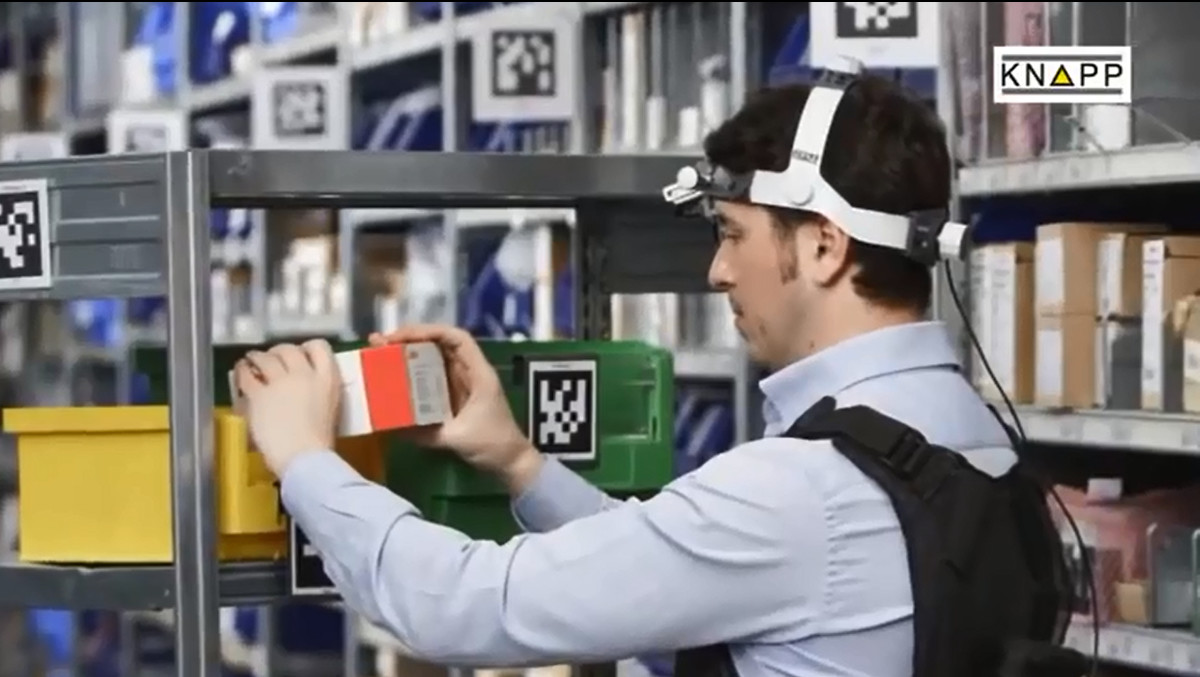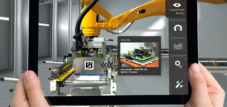Fast and precise order picking is one of the most important tasks in warehouse logistics. In order to increase performance, employees are supported by a variety of assistance systems. These include optical impulse generators (pick-by-light) or mobile aids such as headsets (pick-by-voice).
One of the newer methods for optimizing picking is pick-by-vision with data glasses, which combines the advantages of pick-by-voice and pick-by-light in one system. Thanks to rapid technical progress, smart glasses are now so mature that they can also be used in industrial applications. It is suitable for use wherever manual activities need to be carried out that require additional information. This also includes the warehouse area, where data glasses represent a good interface to provide employees with the necessary information.
Pick-by-vision in the warehouse
In the real implementation, the employee works with data glasses whose display shows relevant data about the current order in real time. With their help, the order picker is guided through the current order. A navigation function takes them directly to the storage location of the item to be picked, where the corresponding storage location and the required number of picks are displayed via a visual display. Optionally, the data glasses can be expanded to include a camera for recording barcodes. This makes the usual hand scanner unnecessary.
The advantage of data glasses is that, in addition to the data projected on the display, the user can still perceive the surroundings without interference and has both hands free to process the order. In addition, he receives immediate feedback if he has made a picking error. To increase precision, additional images of the item can be shown to him via the data glasses.
All information relevant to the order is transmitted in real time from the ERP or WM system and displayed on the data glasses: At the same time, employees and the warehouse management software have a permanent overview of the type, location and quantity of the goods to be picked.
In times of global competition, it is obvious that there is a great need for improved order picking performance. The US market research company Gartner expects that ten percent of all companies will use pick by vision or augmented reality solutions by 2018. studies by the Technical University of Munich, the technology reduces the error rate in picking by twelve percent compared to conventional methods; with a reduction in picking time of around nine percent.
Another advantage is that the acquisition costs are up to fifty percent cheaper than conventional systems. And in contrast to pick-by-voice, data glasses are also suitable for noisy work environments. Added to this is their intuitive user interface, which enormously shortens the training time for new warehouse workers.
Ultimately, the technology depends on its acceptance by end users. In addition to often short battery life or range, the focus in the past has been on the comfort of wearing data glasses. However, individual systems now weigh less than 50 grams. The battery life has also been increased to such an extent that the data glasses last for up to ten hours and thus beyond the duration of a shift.
The company Logcom has brought its Picavi Smart Glasses onto the market, a pick-by-vision solution that allows all work processes in the warehouse to be controlled via the system. Every process step and pick is logged and checked in real time. The external battery, known as Power Control, also offers an alternative to operation via the buttons or touchpads of the data glasses with five integrated and freely assignable buttons. With a weight of 200 grams and handy dimensions, it can be easily attached to the order picker's belt.
Data glasses – application of smart glasses in practice
Logistics / DHL
The logistics company DHL tested the use of data glasses at the end of 2014 as part of a pilot project in a Dutch distribution center. For this purpose, warehouse employees were equipped with special smart glasses for a period of three weeks, on the displays of which information about the items they were looking for was shown during picking. Ten employees used the devices, picking over 20,000 items for 9,000 orders during the period. According to a statement from DHL, the logistics processes could be measurably optimized with the help of the new technology. An increase in efficiency of picking by 25 percent was achieved. The positive experiences led DHL to decide to use the data glasses in two US logistics centers. The smart glasses will be used there primarily during peak times such as Christmas, when a high number of temporary workers is expected. Especially these employees who are not familiar with the local conditions see great potential in the smart glasses due to the short training phase.
Trade & Distribution / Dr. Babor
In its high-bay warehouse, the cosmetics manufacturer Dr. Babor provides 12,000 square meters of packaging and promotional items for shipping to end customers. A total of around 6,000 items are stored there, all of which are picked using the Picavi solution from the manufacturer Logcom. According to Dr. By using the system in order picking, Babor saves time by 18%.
Automotive / VW
After a three-month pilot phase, the VW Group decided in November 2015 to introduce 3D data glasses in the picking area of factory logistics. The primary goal is to increase process reliability in car production. According to Volkswagen, the advantages of data glasses are obvious: With the VW solution, the user automatically receives necessary information in his field of vision, such as the removal location. Touch and voice control including an integrated barcode scanner make handling even easier. The check is carried out immediately after each pick: After scanning the barcodes, correct removals are shown in green, but incorrectly removed items are colored red.


